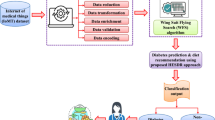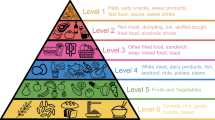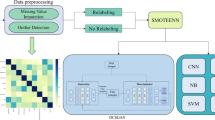Abstract
Due to the growing number of diabetic patients, it is essential to organize and plan balanced nutrition. It is also necessary to recommend certain food products that need to be consumed by diabetic patients effectively. Therefore, this paper develops a novel concept to determine and classify diabetic patients thereby recommending a balanced food diet for a healthy lifestyle. This article comprises two significant phases namely the data pre-processing phase as well as the classification phase. In the classification phase, a novel adaptive identity preserving conditional generative adversarial network-based multi-objective whale slime mold optimization (AIPCGAN-MWSMO) algorithm is proposed to accurately determine the patients affected by diabetes and to recommend nutritional food products based on their health conditions. The proposed approach uses a composition of food integrated dataset (CoFID) dataset to determine the system performance. Finally, comparing the introduced approach over various existing state of art techniques is done with respect to various performance metrics and the accuracy rate achieved for the proposed AIPCGAN-MWSMO approach is 98%.




Similar content being viewed by others
Availability of data and material
Data sharing is not applicable to this article as no new data were created or analyzed in this study.
Code availability
Not applicable.
References
Salim NO, Zeebaree SR, Sadeeq MA, Radie AH, Shukur HM (2021) Study for food recognition system using deep learning. J Phys Conf Ser 1963:012014
Nyati U, Rawat S, Gupta D, Aggrawal N, Arora A (2021) Characterize ingredient network for recipe suggestion. Int J Inf Technol 13(6): 2323–2330. https://link.springer.com/article/https://doi.org/10.1007/s41870-019-00277-y
Balamurugan S, Ayyasamy A, Joseph KS (2022) IoT-Blockchain driven traceability techniques for improved safety measures in food supply chain. Int J Inf Technol 14(2):1087–1098. https://link.springer.com/article/https://doi.org/10.1007/s41870-020-00581-y
Chaudhary S, Suri PK (2021) Framework for agricultural e-trading platform adoption using neural networks. Int J Inf Technol 13(2):501–510
Annamalai R, Nedunchelian R (2022) Design of optimal bidirectional long short term memory based predictive analysis and severity estimation model for diabetes mellitus. Int J Inf Technol. 1–9. https://link.springer.com/article/https://doi.org/10.1007/s41870-022-00933-w
Subramaniyaswamy V, Manogaran G, Logesh R, Vijayakumar V, Chilamkurti N, Malathi D, Senthilselvan N (2019) An ontology-driven personalized food recommendation in an IoT-based healthcare system. J Supercomput 75(6):3184–3216
Gao X, Feng F, Huang H, Mao XL, Lan T, Chi Z (2022) Food recommendation with graph convolutional network. Inf Sci 584:170–183
Iwendi C, Khan S, Anajemba JH, Bashir AK, Noor F (2020) Realizing an efficient IoMT-assisted patient diet recommendation system through a machine learning model. IEEE Access 8:28462–28474. https://doi.org/10.1109/ACCESS.2020.2968537
Rostami M, Oussalah M, Farrahi V (2022) A novel time-aware food recommender-system based on deep learning and graph clustering. IEEE Access
Gulati R, Bhagat M (2021) Content and knowledge based food recommending intelligence enabled system (FRIES). In: 2021 5th International Conference on Computing Methodologies and Communication (ICCMC), pp 1743–1749
Ogbolumani OA, Nwulu NI (2021) Multi-objective optimisation of constrained food-energy-water-nexus systems for sustainable resource allocation. Sustain Energy Technol Assess 44:100967
Doliente SS, Samsatli S (2021) Integrated production of food, energy, fuels and chemicals from rice crops: multi-objective optimisation for efficient and sustainable value chains. J Clean Prod 285:124900
Medina-Vera I, Sanchez-Tapia M, Noriega-López L, Granados-Portillo O, Guevara-Cruz M, Flores-López A, Avila-Nava A, Fernández ML, Tovar AR, Torres N (2019) A dietary intervention with functional foods reduces metabolic endotoxaemia and attenuates biochemical abnormalities by modifying faecal microbiota in people with type 2 diabetes. Diabetes Metab 45(2):122–131. https://doi.org/10.1016/j.diabet.2018.09.004
Manikandan K (2019) Diagnosis of diabetes diseases using optimized fuzzy rule set by grey wolf optimization. Pattern Recogn Lett 125:432–438. https://doi.org/10.1016/j.patrec.2019.06.005
Sarno R, Sabilla SI, Wijaya DR (2020) Electronic Nose for Detecting Multilevel Diabetes using Optimized Deep Neural Network. Eng Lett 28:1
Devi RDH, Bai A, Nagarajan N (2020) A novel hybrid approach for diagnosing diabetes mellitus using farthest first and support vector machine algorithms. Obes Med 17:100152. https://doi.org/10.1016/j.obmed.2019.100152
Pranoto H, Heryadi Y, Warnars HLHS, Budiharto W (2021) Enhanced IPCGAN-Alexnet model for new face image generating on age target. J King Saud Univ Comput Inf Sci 2:2
Traka MH, Plumb J, Berry R, Pinchen H, Finglas PM (2020) Maintaining and updating food composition datasets for multiple users and novel technologies: Current challenges from a UK perspective. https://doi.org/10.1111/nbu.12433
Funding
Not applicable.
Author information
Authors and Affiliations
Contributions
All authors agreed on the content of the study. RMV and RM collected all the data for analysis. RMV agreed on the methodology. RMV and RM completed the analysis based on agreed steps. Results and conclusions are discussed and written together. The author read and approved the final manuscript.
Corresponding author
Ethics declarations
Conflicts of interest
The authors declare that they have no conflict of interest.
Ethics approval
This article does not contain any studies with human participants.
Human and animal rights
This article does not contain any studies with human or animal subjects performed by any of the authors.
Informed consent
Informed consent was obtained from all individual participants included in the study.
Consent to participate
Not applicable.
Consent for publication
Not applicable.
Rights and permissions
Springer Nature or its licensor (e.g. a society or other partner) holds exclusive rights to this article under a publishing agreement with the author(s) or other rightsholder(s); author self-archiving of the accepted manuscript version of this article is solely governed by the terms of such publishing agreement and applicable law.
About this article
Cite this article
Rachitha, M.V., Ramakrishna, M. MWSMO: Multi-objective Whale Slime Mold Optimization based Food Recommendation system for Diabetes patient using GAN model. Int. j. inf. tecnol. 15, 2357–2363 (2023). https://doi.org/10.1007/s41870-023-01228-4
Received:
Accepted:
Published:
Issue Date:
DOI: https://doi.org/10.1007/s41870-023-01228-4




